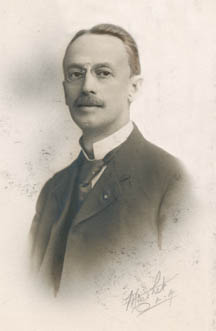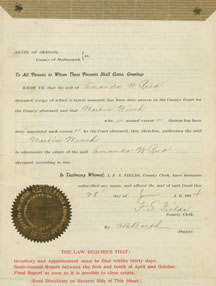
IRIS login | Reed College home Volume 90, No. 1: March 2011
Fighting for Amanda's Dream
In 1905, eleven heirs of Amanda Reed filed suit to break her will and claim her fortune. Only one man—the twelfth heir—could save her dream from destruction.
By Ted Katauskas

Martin Winch: a hint of defiance in his eyes.
On May 11, 1912, thousands of people converged on a muddy cow pasture on the east side of the Willamette River to witness a momentous occasion—the laying of the cornerstone of the Arts and Sciences building (now known as Eliot Hall), the first permanent structure on the Reed campus. Excitement among Portland’s citizenry ran so high that organizers secured a train of 11 cars to carry the throng to the remote location.
After leading a rousing chorus of “America the Beautiful,” Dr. William T. Foster, the college’s first president, stepped forward and positioned a copper box on a granite slab beneath the gently swaying cornerstone while Charles H. Dodge, grand chaplain of the Masonic order, recited a list of the box’s contents.
“The tackle that held the stone suspended over its bed creaked, the slab settled gently into its place and the grand master tapped free the steel pins with which it had been suspended,” recounted the Oregonian. “Then he completed the ceremony of sprinkling the stone with the symbolic grains of corn, wine and oil, and turning, mounted the rostrum and spoke the closing words of the ceremony, prophesying a worthy building, housing a great institution.”
The grand celebration drew many of Portland’s most prominent citizens, but one face was conspicuously absent from the crowd.
Martin Winch, the nephew of Amanda and Simeon Reed, and the executor of their will, was nowhere to be seen. His absence was particularly striking because he played a monumental role in the creation of Reed College. Without Winch, the college would almost certainly have been stillborn, strangled by heirs seeking to claim Amanda Reed’s fortune for themselves.
Alone among these heirs, Winch, a social misfit with barely a high school education, took it upon himself to champion his aunt’s dream and rescue her legacy from the clutches of self-interested relatives in one of the most sensational court battles in Portland’s history.
The dispute made him a pariah in his own family. But that was just the beginning. Obsessed with fulfilling the dying wishes of his aunt and uncle, Winch spent the next four years jousting with his fellow trustees over the academic soul of the college. He ultimately lost—lost not just the battle, but the friendship of the only person who truly understood him.
You get a hint of his isolation from a photograph taken mid-life, a stiff formal portrait of Winch gazing expressionless at the camera, receding hair oiled and parted down the middle, moustache neatly trimmed, eyes peering with a hint of defiance through barely noticeable frameless round spectacles balanced upon the bridge of his nose.
But to gain a sense of how this drama played out, to render more than a two-dimensional daguerreotype image of who Winch really was, you need to travel backward in time, carefully sifting cubic feet of brittle-to-the-touch paper—letters, court transcripts, ledgers, telegrams, and newspaper clippings—archived in the sub-basement of Hauser Library and in the vault of the Oregon Historical Society.
Many pieces are missing from the historic record and may never be found. But with perseverance, it’s possible to assemble the most obvious pieces of the jigsaw into a border that frames the complicated and tragic puzzle of Martin Winch.
For as long as he could remember, Winch had worshipped his Uncle Sim. Growing up in Quincy, Massachusetts, the boy heard endless stories about the colorful character who quit school at 15, cut leather in a shoe factory, and then spirited his bride, Amanda, off to the wilds of Oregon to seek his fortune.
When Simeon Reed arrived in the Pacific Northwest in 1852, Oregon was still a territory and Portland was a trading outpost with fewer than a thousand inhabitants, isolated from the rest of the world. The city’s only link to civilization was the steamship. Sensing an opportunity, Simeon invested his earnings in a startup that grew into the biggest shipping line in the Northwest, the Oregon Steam Navigation Company—the Google of its day.
The startup flourished and Simeon became a millionaire. He flaunted it. He built a garish mansion, a filigreed edifice with a slate roof perched atop a grassy knoll, with a burbling fountain and a cow grazing on the lawn. A founding member of the Arlington Club and an avid hunter (but not a good shot: an accident claimed two fingers on his dominant hand), he was a flashy dresser and drove a landau carriage with sterling harnesses to church. With a quick wit and a round belly, he was the toast of Portland’s elite despite the fact that he was clearly nouveau riche (“Mr. Reed’s taste was always for the gaudy,” recalled one friend).
Amanda Reed on the other hand, was the yin to Simeon’s yang: petite, reserved, a homebody who shunned ostentation, delighted in the laughter of children, and for their pleasure, purchased a magic lantern and a music box.



LATEST COMMENTS
steve-jobs-1976 I knew Steve Jobs when he was on the second floor of Quincy. (Fall...
Utnapishtim - 2 weeks ago
Prof. Mason Drukman [political science 1964–70] This is gold, pure gold. God bless, Prof. Drukman.
puredog - 1 month ago
virginia-davis-1965 Such a good friend & compatriot in the day of Satyricon...
czarchasm - 4 months ago
John Peara Baba 1990 John died of a broken heart from losing his mom and then his...
kodachrome - 7 months ago
Carol Sawyer 1962 Who wrote this obit? I'm writing something about Carol Sawyer...
MsLaurie Pepper - 8 months ago
William W. Wissman MAT 1969 ...and THREE sisters. Sabra, the oldest, Mary, the middle, and...
riclf - 10 months ago